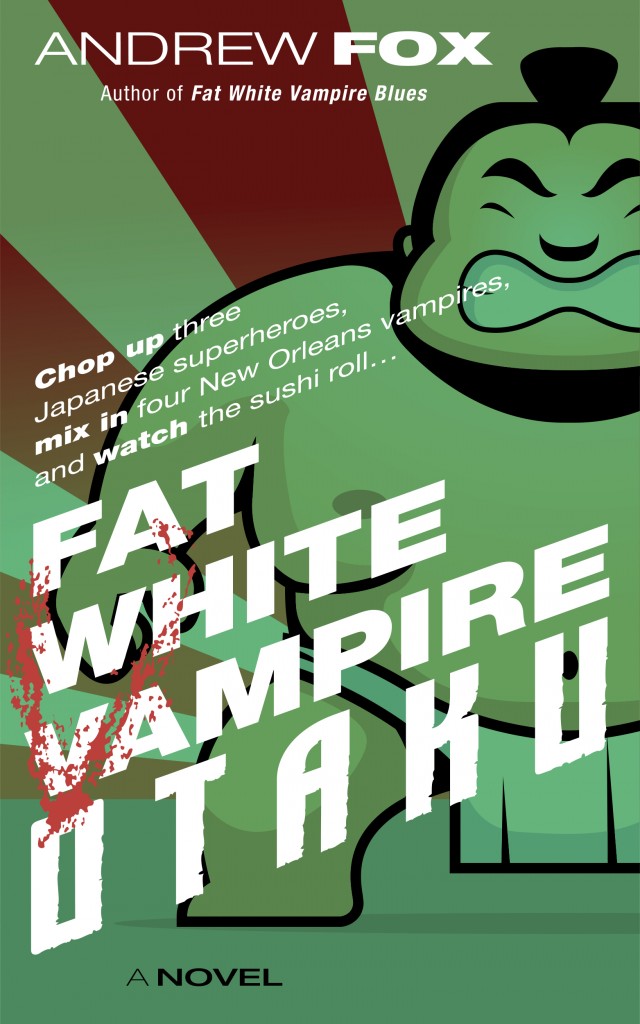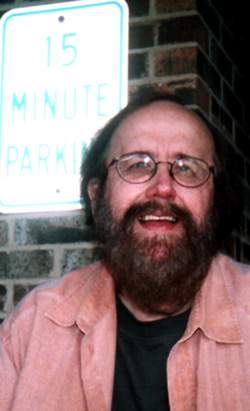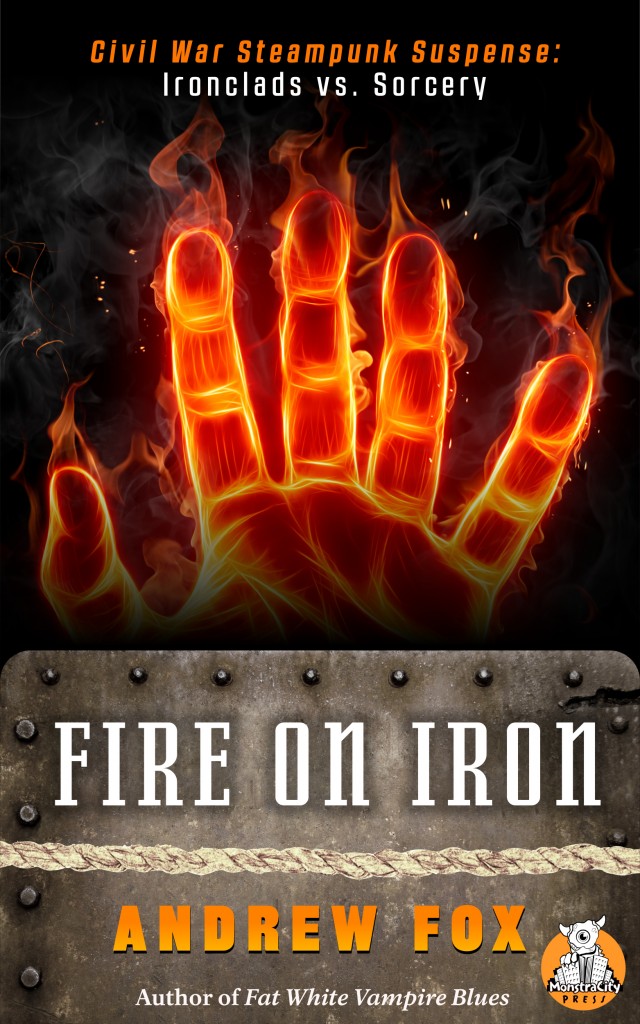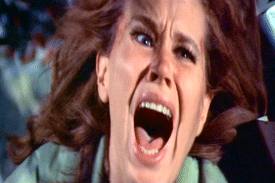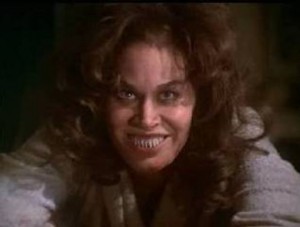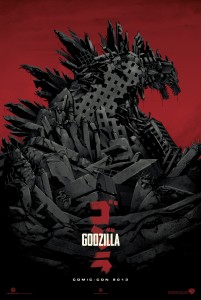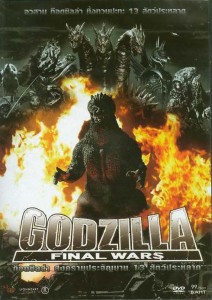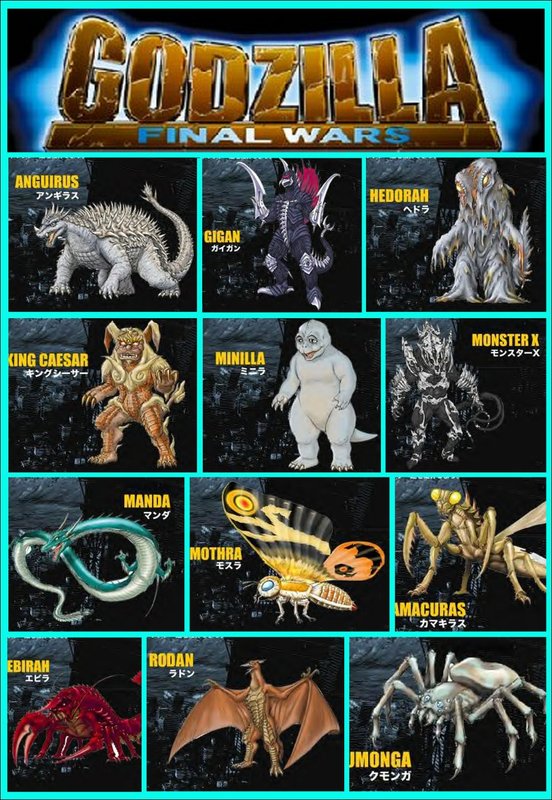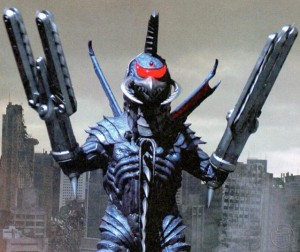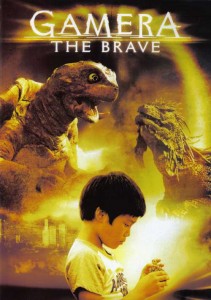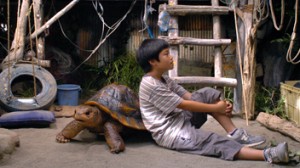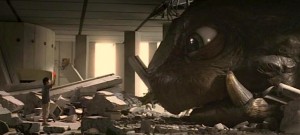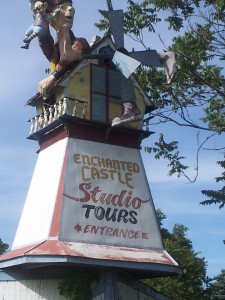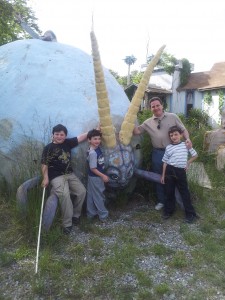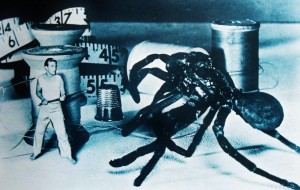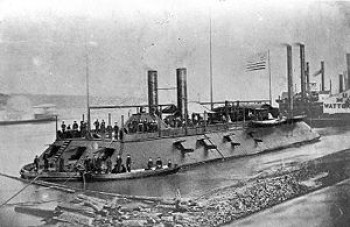My update to my Upcoming Projects page can be found here. You may be surprised to see how many books I have in the pipeline, including several that will be published later this year by MonstraCity Press. See my Upcoming Projects page for brief descriptions of books 4-6 of the Fat White Vampire series and books 2-4 of the August Micholson Chronicles series, along with descriptions of several stand-alone science fiction novels which I have written and the first three books of the Mount MonstraCity series for middle grade readers (each of which has been written). I hope you’re as excited as I am!
Archive for Horror and Fantasy
Fat White Vampire Otaku Next Up
Coming next from MonstraCity Press is the third in the Fat White Vampire/Jules Duchon series, Fat White Vampire Otaku. Just what is an otaku, you might ask? Otaku is Japanese for “fan boy” or “fan girl.” Jules and his vampire friends get to sample the blood of a trio of Japanese superheroes after the devastating Hurricane Antonia rolls through New Orleans. The effects of that blood (at least some of it) on Jules and his friends cause them to become big-time otaku of their visiting pals, the Japanese superheroes… before chaos erupts! And you know chaos HAS to erupt, because this is a Fat White Vampire book!
My wife Dara, my partner in MonstraCity Press, has been working hard on proofing and formatting this third book in the Fat White Vampire series. We are aiming for a late April to mid-May roll out of the book. The ebook versions will arrive first, to be followed by a trade paperback version. Watch this space, as I’ll keep you all informed as of our progress!
(Reality check: Dara and I have had our hands full with Levi’s health problems recently, so it is possible that the publication date of Fat White Vampire Otaku may be pushed back a month or two. I’ll continue to keep you all updated.)
My Friend, Lucius Shepard (August 21, 1943–March 18, 2014)
Many obituaries, many still to be written the world over, will focus on Lucius Shepard’s tremendous body of work in the science fiction and fantasy field. Having known Lucius personally, I’d like to take a different tack. I’d like to focus on the Lucius who was such a good friend to my family and to me.
I had the great pleasure of meeting Lucius not too long after my first novel, Fat White Vampire Blues, hit the bookstores. I believe the first time Lucius and I spoke was at the World Fantasy Convention in Tempe, Arizona just before Halloween of 2004, when my first son, Levi, was less than a year old. Dara and I dressed Levi in a little gorilla costume for Halloween, and we walked from the hotel for some dinner with Lucius. When he found out who I was, Lucius said he’d read my book and told me to expect my protagonist, Jules Duchon, to receive fan mail.
A year later, at ArmadilloCon in Austin, Texas, Dara and I saw Lucius again. He mentioned that he’d be coming down to New Orleans to do research at the Tulane University library on William Walker for a book he was writing. Dara and I told him he should stay at our home on the West Bank of New Orleans and that I would be happy to drive him each day to the library and pick him up from the Algiers Ferry landing. While he was staying with us, one of my dining room chairs broke while he was sitting in it. Rather than getting indignant about how the incident might reflect on his great size and weight (Lucius was a big guy), he was incredibly apologetic about breaking my chair. To me, that’s Lucius in a nut shell… a gentle, polite giant, a sort of huge tame bear who had somehow wandered into our home.
This impression I had of him was only solidified later that evening. Dara’s and my cat, Snagglepuss, seemingly escaped the house when Lucius went outside for a cigarette break. Lucius and I spent an hour and a half driving through the neighborhood in search of that cat. I’ll never forget Lucius’s oddly high-pitched voice calling out, “Here, Snaggy! Here, Snaggy, Snaggy, Snaggy!” We later found the cat hiding in one of the rooms inside our home, so he’d never gotten out in the first place. But I’ll never forget Lucius’s very sincere concern. How strange it was, to have had one of the brightest stars in American literature sitting next to me in my little blue Ford Focus, calling out the window for a missing cat!
Lucius did something very special and very touching for me when my family and I were trapped outside our home for months in the aftermath of Hurricane Katrina. Knowing that there was a good possibility that my entire collection of books had been destroyed by the hurricane’s floods (they weren’t, after all, since Dara and I were fortunate enough to live on the West Bank, in a separate flood zone from the rest of New Orleans—but Lucius didn’t know that, and neither did we at the time), and also knowing I had no reading material at the Florida condo where my family and I had taken shelter, Lucius shipped to Florida a carton of all of his books, signed and personalized. I have them on my shelves still.
Sad to say, Lucius and I did not stay in close touch after Hurricane Katrina. We never had any sort of a falling-out; we both just found ourselves too busy to do more than follow each other’s ups and downs on Facebook. I would send him “get well soon!” messages whenever I read that he had had an eye operation or that he was laid up with some sort of an illness (which happened distressingly frequently).
The last time we spoke was the Sunday morning before I suffered my own personal mental breakdown (due to issues completely unrelated to Lucius). A friend of Lucius’s, along with The Magazine of Fantasy and Science Fiction’s editor, Gordon Van Gelder, had each emailed me and asked me if I would call Lucius at home so that he could practice his speech. He had suffered a stroke and needed to speak with friends he was comfortable with so that he could regain his speaking abilities. When I reached Lucius that morning, he was astoundingly upbeat about his prospects. I remember telling him, “Lucius, if I ever suffer anything like what you’re going through, I hope I can face it with half the bravery and fortitude you’re showing me this morning. All I can say is, you are a superhero!”
The very next day, I suffered physical symptoms related to my emotional breakdown which mirrored the impact of a stroke. A few weeks after I got out of the hospital, I sent Lucius a message on Facebook telling him about my experience and praising him as my role model; my experience of his bravery and fortitude had helped me get through that awful week in the mental hospital.
I don’t know whether Lucius ever received that message; I don’t know whether his stroke allowed him to check his Facebook messages. I also tried reaching him on the phone again, without success. But I hope he saw it.
Farewell, Lucius. As a friend, a writer, and a human being, you were a superhero to me!
Fire on Iron Now Available in Paperback!
For those of you who prefer to read your books in print, rather than in pixels, my newest book, Fire on Iron, is now available in trade paperback format for the price of $15.95.
And of course, Fire on Iron remains available in the following ebook formats for the bargain price of $2.99:
And if you are a diehard Kindle fan, the Kindle version is available for the price of $5.99.
I’m currently working on the last few chapters of the second book in my series which began with Fire on Iron, Midnight’s Inferno: the August Micholson Chronicles. The new book will be called Hellfire and Damnation. Now’s your chance to get in on the ground floor of a brand-new, exciting Civil War steampunk suspense series!
One more time, here’s the back cover blurb:
“What price redemption? Is martial honor worth the cost of one’s soul?
“Lieutenant Commander August Micholson lost his first ship, the wooden frigate USS Northport, in reckless battle against the rebel ironclad ram CSS Virginia. However, Flag Officer Andrew Foote offers the disgraced young Micholson a chance to redeem himself: he can take the ironclad gunboat USS James B. Eads on an undercover mission to destroy a hidden rebel boat yard, where a fleet of powerful ironclads is being constructed which will allow the Confederate Navy to dominate the Mississippi.
“But dangers far more sinister than rebel ironclads await Micholson and his crew. On the dark waters of the Yazoo River, deep within rebel territory, they become entangled in a plot devised by a slave and his master to summon African fire spirits to annihilate the Federal armies. Micholson must battle devils both internal and external to save the lives of his crew, sink the Confederate fleet, and foil the arcane conspiracy. Ultimately, Micholson is faced with a terrible choice — he can risk the lives of every inhabitant of America, both Union and Confederate, or destroy himself by merging with a demon and forever melding his own soul with that of his greatest enemy.”
Fire on Iron Available for $2.99 in New Formats
My newest book, Fire on Iron, is now available in the following new ebook formats:
And the REALLY BIG DEAL is that Fire on Iron is available in these three new formats for the bargain price of only $2.99!
That’s HALF the price you will currently pay for a Kindle copy!
Dara and I are in the process of lowering the Kindle price to match the Nook, Smashwords, and iTunes price, but we’ve been just a wee bit distracted by all the chaos in our household these past few months (as anyone who has been following this blog is aware). We’ll get it done… just can’t say exactly when.
Also, yes, the trade paperback version from CreateSpace will be available very soon… also a victim of household chaos, but it shouldn’t be too much longer, so keep watching this space for an announcement.
And if you’d like to sample some of the early readers’ reviews, Fire on Iron currently has a 4.4 STARS rating on Amazon. So check it out!
FREE .PDF Copy of Fire on Iron
Any one out there in InternetLand interested in a FREE .pdf copy of my newest book, Civil War steampunk supernatural suspense novel Fire on Iron?
If you are, just send me your email address, either by leaving a comment to this post or by using the Contact Me feature. I’ll have Dara send you a .pdf copy, along with instructions for how to access it on your smart phone, tablet, or laptop.
I ask but one favor in return — please post a review to Amazon after you’ve read the book. Hit me with your best shot; I want honest reviews. I’m confident in how much you’ll enjoy the book. Dara and I would like to do some advertising on sites which promote ebooks, but they generally have requirments that books which are advertised must have a minimum of twenty Amazon reviews. We’re trying to get there, and you can be a huge help (along with getting a free book to read, the first in a new series!).
Here’s the back cover copy, to whet your appetite:
In 1862, Lieutenant Commander August Micholson, captain of the Union ironclad U.S.S. James B. Eads, leads his crew on a hazardous undercover mission. Their task? To destroy a hidden Confederate boat yard, where a fleet of rebel ironclads is being constructed which will allow the Confederate Navy to dominate the Mississippi and bombard Northern river cities into submission.
This is Micholson’s last chance for redemption. Weeks earlier, he lost his frigate, his best friend, and over a hundred members of his crew during a disastrous battle against the Confederate ironclad ram C.S.S. Virginia. Flag Officer Foote, commander of the Western Flotilla, believes Micholson’s ordeal and his terrible memories of the power of a rebel ironclad will give him the psychological edge he needs to prevail. Micholson’s crew, however, only knowing their new captain from scuttlebutt and scathing newspaper reports, fear he will lead them all to their deaths.
Micholson leads his crew on a false flag operation, pretending to be a turncoat who has switched to the rebel cause following his censure in the North. On the dark, muddy backwaters of the Yazoo River, the Eads becomes entangled in a plot devised by a slave and his rebel master to summon African fire spirits to annihilate the Federal armies. Micholson must battle demons both internal and external to save the lives of his crew, sink the Confederate fleet, and foil the arcane conspiracy. The Union men manage to prevail again and again against overwhelming enemy forces. Yet the machinations of the African sorcerer M’Lundowi, who hates the people of the Union and the Confederacy equally, threaten to undo all of their victories.
Ultimately, Micholson is faced with a terrible choice — imperiling the lives of every inhabitant of North America, or taking a demon into his body and melding his soul with that of his greatest enemy.
*********************************************************************
If you’d prefer to read the novel on your Kindle, here’s a link to the Kindle version:
Buy Fire on Iron for the Kindle
More electronic formats and paperback version coming very soon!
Horrified by Obamacare? Take a Prescription from These 13 Evil Doctors and Nurses
Today is Halloween, America’s horror holiday. Health care is all over the news, with millions of Americans HORRIFIED by cancelled health insurance policies, skyrocketing insurance rates, and a government-run website which devours one’s hours and exposes one’s personal info to all the world’s Internet scammers. We could all use a distraction. So what could be a better prescription for Halloween distraction than a Top Thirteen List of Pop Culture’s Most Evil Doctors and Nurses?
Notice – this is a list of the most evil, not the most famous. So I’m not including the most famous mad doctor of them all, Dr. Victor Frankenstein (or, in the movie version, Dr. Henry Frankenstein). I’m leaving out the good Dr. Frankenstein because he really is the good Dr. Frankenstein – he embarks upon his experiments with the purest of intentions, wanting only to further the cause of Science and advance mankind’s knowledge. He doesn’t intend to unleash a homicidal monster on the world. (Unlike, perhaps, the drafters of the 1100 page Obamacare law.)
So here’s my list of a baker’s dozen Evil Doctors and Nurses, going from Least Evil to Most Evil.
(13) Zombie Nurse from Dawn of the Dead (1978)
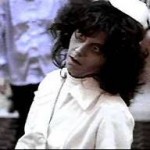
Okay, technically, Zombie Nurse isn’t really evil… she’s just misguided, and really, really hungry. But she’s one of the bit players from George A. Romero’s horror classic who never fades from your mind. Because isn’t the notion of a nurse who wants to devour your flesh just a wee bit disturbing?
(12) Dr. Genessier from Eyes Without a Face (1960)

Climbing the evil scale just a bit, we come to Dr. Genessier, protagonist of Georges Franju’s atmospheric Franco-Italian co-production. Yes, he’s a murderer, but he has the best interests of his daughter, Christiane, at heart. Don’t take that at face value, however; Dr. Genessier’s game is to acquire a fresh face for Christiane, who has been horribly disfigured in a fire. His pursuit of Christiane’s happiness involves multiple heterograft surgeries, the removals of entire faces from healthy young women. Unfortunately, Christiane’s body rejects them, one after one. What’s a daddy to do, when his daughter is so unpleasable?
(11) Dr. Bill Cortner from The Brain That Wouldn’t Die (1959)
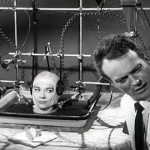
Dr. Cortner faces a similar dilemma to that of Dr. Genessier. In this case, it’s his fiancée, Jan, who desperately requires his medical skills. Poor Jan was decapitated in a car wreck, but clever Dr. Cortner finds a way to keep her head alive… sort of. Of course, being mounted on a liquid-filled tray isn’t much of a life, so the good doctor goes in search of a donor of a body from the neck down. Not too many of those get advertised on Craig’s List, unfortunately…
(10) Nurse Ratched from One Flew Over the Cuckoo’s Nest (1975)
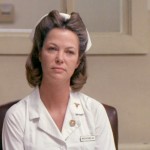
Nurse Ratched may be the most subtle evil practitioner of medicine on this list. She doesn’t do anything overtly bad to any of the patients at the Oregon State Hospital; any accrediting auditor who would follow her around to observe quality of care would probably give her high marks for professionalism. Still, she drives one patient to suicide, maneuvers another into a lobotomy, and destroys the self-esteem of the whole lot. A career-making (and career-destroying) performance by Louise Fletcher, who won an Academy Award for Best Actress and became so associated with Nurse Ratched that she was never offered another role a tenth as good.
(9) Master George Sims from Bedlam (1946)
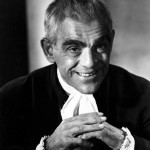
I had to get Boris Karloff on this list somehow. He played an entire platoon of mad doctors over his lengthy career, including a descendant of Dr. Victor Frankenstein in Frankenstein 1970. But I do believe the most evil doctor he portrayed was Master George Sims, who was based upon the real-life Dr. John Monro, chief physician of the infamous Bethlem Royal Hospital. Sims takes a sadistic delight in showing off the the peculiarities of his mental patients to any curious observers, and he is more than willing to abuse his legal powers and commit any critics of his practices to his asylum. Perhaps Nurse Ratched is a descendant?
(8) Dr. Caligari from The Cabinet of Dr. Caligari (1920)
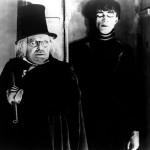
In this masterpiece of German Expressionist cinema, Dr. Caligari cruelly exploits a zombie-like somnambulist, Cesare, both to earn him an income as a carnival attraction and to murder the doctor’s enemies. The film’s twist ending (one of cinema’s first) deflates Caligari’s evil considerably; but for the first nine-tenths of the film, Werner Krauss’s mad hypnotist provides a lurid archetype for all the hundreds of mad doctors to follow.
(7) Dr. Robert Suzuki from The Manster (1959)
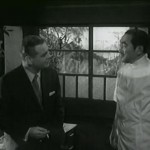
This Japanese-American co-production, an early example of tokusatsu (Japanese film or TV which relies heavily on special effects), probably shows up on nobody’s list of horror classics. But its mad doctor, Dr. Robert Suzuki, appears on this list at #7 because he is such a conniving manipulator and sneak. He pulls an awful stunt on American news correspondent Larry Stanford, who only means to do the doctor a favor by writing a puff piece on him; Dr. Suzuki slips him a mickey, knocks him out, and injects him in the neck with an experimental serum meant to chemically induce evolutionary change. Oh, but that isn’t all – once poor Larry wakes up, completely unaware his veins are full of monster-making juice, Dr. Suzuki butters him up, convincing him to stay in Japan longer than he’d planned (so the good doctor can observe the results of his work). He hooks Larry up with a voluptuous assistant, Tara, and wines and dines him after taking him to some swanky nightclubs and massage baths. Meanwhile, Larry is growing a second head on the side of his neck. Hope the sushi was worth it, Larry!
(6) Dr. Innes and Dr. Morris from Seconds (1966)
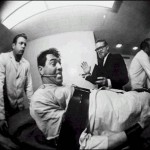
Talk about your bait-and-switch (and how appropriate, since we’re also talking Obamacare). All middle-aged sad-sack Arthur Hamilton wants is a chance at a new life. The doctor-entrepreneurs of The Company offer him just that: a brand-new life as Rock Hudson, following a few days’ worth of plastic surgery. What the poor shmuck doesn’t realize is how badly he’ll come to miss his old life. But once he’s signed on the dotted line, there’s no going back. As soon as he voices his displeasure too strongly, the docs and their orderlies put the hurt on him and disassemble him into fresh parts for new clients. Old Arthur didn’t read the small print at the bottom of that HIPAA release form…
(5) Dr. Christian Szell from Marathon Man (1976)
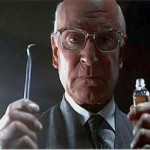
We need at least one Nazi dentist on this list, and Dr. Szell is it. Nobody who sees this movie will ever forget what Laurence Olivier’s Nazi war criminal dentist does inside Dustin Hoffman’s mouth. This film has probably been responsible for more dental care procrastination than any other movie in the history of cinema.
(4) Dr. William Michaels from The M.D.: A Horror Story (1992)

This horror novel by the extraordinarily gifted writer Thomas M. Disch hasn’t yet been adapted into a film, but it should be. Dr. Michaels is the possessor of a magical caduceus, a talisman he has owned since childhood. The caduceus is capable of miraculous feats of healing. But in order to do so, it must first be “charged” with the energies stemming from monstrous acts of evil. Dr. Michaels learns he enjoys using the caduceus for evil every bit as much as he does using it for healing. Perhaps even more…
(3) Dr. Moreau from Island of Lost Souls (1932)
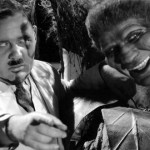
In this first film adaptation of H. G. Wells’s The Island of Dr. Moreau (1896), Charles Laughton’s Dr. Moreau has no redeeming qualities. Unlike Dr. Frankenstein, he does not seek to aid mankind. Unlike Doctors Genessier and Cortner, he isn’t trying to do a solid for a daughter or fiancée. His goal, it seems, is to bring more human beings into the world; but any twelve-year-old who has gone through a sex education class could tell him there are easier ways to do this than to vivisect hundreds of innocent, helpless animals. This is a man who would gladly cut up Bambi and Rin-Tin-Tin. That’s just evil.
(2) Dr. Elliot Mantle/Dr. Beverly Mantle from Dead Ringers (1988)
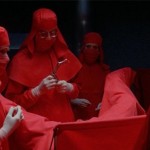
I am not easily creeped out by a movie. But this David Cronenberg flick about twin brother gynecologists did it for me. I nearly crawled out of my skin watching this. Couldn’t make it through to the end. They might not be the most evil doctors on this list, but the Doctors Mantle, with their eager application of medieval torture device gynecological instruments to Genevieve Bujold’s mutant lady-parts, are certainly the most unsettling of the bunch.
(1) Dr. Josef Mengele from The Boys from Brazil (1978)
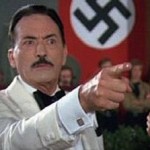
And coming in at #1 is history’s most nefarious and infamous evil doctor, utilized by best-selling author Ira Levin as the villain of his 1976 science fiction thriller, made into a popular film two years later. In book and movie, Dr. Mengele wants to recreate his beloved Fuhrer through cloning, certainly evil enough to get him to the top of this list. My only misgiving about Mengele’s depiction here is the very odd casting of Gregory Peck. I mean, come on, who can believe that Atticus Finch is history’s greatest monster doctor? Laurence Olivier was in this one, too, but as a Nazi-hunter, this time. Maybe after his star-turn as evil dentist Dr. Szell two years earlier, he figured he’d done his quota of Nazi roles. Too bad.
So, there’s our list! Keep an eye out for these particular doctors and nurses. Obamacare promises to vastly increase the demand for medical care, but does nothing to increase the supply. So these thirteen paragons of mercy and healing may be called out of retirement… to staff an Obamacare clinic near you!
Fire on Iron Now Available for Kindle!
Kudos to my lovely (and hardworking) wife, Dara, on reaching her first milestone with MonstraCity Press: publishing my steampunk supernatural suspense novel, Fire on Iron, to the Kindle platform! Dara opted to go the “extra mile” with publishing to Kindle, not relying on one of the automatic conversion utilities to convert the book from a Word document to the Kindle format. Instead, she spent a couple of months learning HTML code so she could ensure a uniform reading experience for all Kindle customers, no matter their hardware. It was a steep learning curve, but she made it to the first plateau. Now, onwards and upwards to CreateSpace, Nook, and Smashwords!
Fire on Iron is Book One of Midnight’s Inferno: the August Micholson Chronicles. This is a brand-new series, a steampunk supernatural suspense adventure set during the American Civil War. Here is the description:
“What price redemption? Is martial honor worth the cost of one’s soul?
“Lieutenant Commander August Micholson lost his first ship, the wooden frigate USS Northport, in reckless battle against the rebel ironclad ram CSS Virginia. However, Flag Officer Andrew Foote offers the disgraced young Micholson a chance to redeem himself: he can take the ironclad gunboat USS James B. Eads on an undercover mission to destroy a hidden rebel boat yard, where a fleet of powerful ironclads is being constructed which will allow the Confederate Navy to dominate the Mississippi.
“But dangers far more sinister than rebel ironclads await Micholson and his crew. On the dark waters of the Yazoo River, deep within rebel territory, they become entangled in a plot devised by a slave and his master to summon African fire spirits to annihilate the Federal armies. Micholson must battle devils both internal and external to save the lives of his crew, sink the Confederate fleet, and foil the arcane conspiracy. Ultimately, Micholson is faced with a terrible choice — he can risk the lives of every inhabitant of America, both Union and Confederate, or destroy himself by merging with a demon and forever melding his own soul with that of his greatest enemy.”
I have many intriguing twists and turns in store for my beleaguered protagonist, August Micholson – he begins his adventures as a Lieutenant Commander in the Union Navy, assigned to an extremely hazardous undercover mission behind Confederate lines. By the end of the first book, he is on his way to becoming a steampunk amalgam of Dr. Strange and the Human Torch, with the added hang-up of having to deal with sharing his skull with two very unwelcome “guests.”
Dara and I plan to make Fire on Iron available in all the popular e-formats within a few weeks, as well as available as a trade paperback. So please watch this space for more announcements.
I’m already at work on Book Two of Midnight’s Inferno: the August Micholson Chronicles, which will be entitled Hellfire and Damnation. Look for that one in the summer of 2014!
Fire on Iron Coming in October!
I am very, VERY pleased to announce that the first book to be published by MonstraCity Press will be my steampunk supernatural suspense novel, Fire on Iron. It will be available in all the popular ebook formats and as a trade paperback this October. The first of many projects to come from MonstraCity Press!
Here is the back cover copy:
“What price redemption? Is martial honor worth the cost of one’s soul?
“Lieutenant Commander August Micholson lost his first ship, the wooden frigate USS Northport, in reckless battle against the rebel ironclad ram CSS Virginia. However, Flag Officer Andrew Foote offers the disgraced young Micholson a chance to redeem himself: he can take the ironclad gunboat USS James B. Eads on an undercover mission to destroy a hidden rebel boat yard, where a fleet of powerful ironclads is being constructed which will allow the Confederate Navy to dominate the Mississippi.
“But dangers far more sinister than rebel ironclads await Micholson and his crew. On the dark waters of the Yazoo River, deep within rebel territory, they become entangled in a plot devised by a slave and his master to summon African fire spirits to annihilate the Federal armies. Micholson must battle devils both internal and external to save the lives of his crew, sink the Confederate fleet, and foil the arcane conspiracy. Ultimately, Micholson is faced with a terrible choice — he can risk the lives of every inhabitant of America, both Union and Confederate, or destroy himself by merging with a demon and forever melding his own soul with that of his greatest enemy.
“Book 1 of Midnight’s Inferno: the August Micholson Chronicles”
I believe my protagonist August Micholson will be rather unique – a steampunk amalgam of Dr. Strange and the Human Torch, with a great deal of multiple-personality complications mixed in. My next project will be the second book in the Midnight’s Inferno series.
More news to come, both regarding the Midnight’s Inferno books and other exciting projects from MonstraCity Press – so watch this space!
A The Frisky Article Which Should Appeal to a Certain Plus-Sized Vampire
Perusing the Internets, I came across a link to an evocatively entitled article, “Girl Talk: How Having Sex With a Fat Guy Changed Me.” Before you all go scurrying off to follow the link yourselves, let me warn you that (as with many articles I’ve encountered at this site) the title promises a pay-off way, way beyond what the article itself delivers. I believe this is called “link bait.” (Hey, it works; I’m linking.)
Anyway, the couple of minutes I spent reading this rather disappointingly limp article got me thinking of great “link bait” titles for other articles in this vein, titles the editors of The Frisky might come up with after a few nights spent in bed with copies of Fat White Vampire Blues and Bride of the Fat White Vampire. Here are a few suggestions:
How Watching a Fat Man Transform Himself into 180 Plump White Rats Changed My Feelings About Rodents
How Being Fed Three Quarters of the Menu at Ralph’s Po-Boys Emporium by a Nosferatu of Size Changed My Opinions of Moderately Priced New Orleans Restaurants
How Being Forced to Imagine a Fat, Starving Vampire Change Himself into a Wolf, Scarf Down Three Bags of Stolen Dog Chow, and Then Have Unintentional Doggy-Style Sex with a Stray Mutt Changed My Inclination to Donate to the SPCA’s Spaying and Neutering Fund
How Reading the Tales of a Washed-Up, 450-Pound Vampire Bragging About His Glory Days as a Masked Superhero During World War Two Changed My Willingness to Tolerate Cross-Genre Experiments by First-Time Novelists
Are you listening, Frisky editors? Link bait like this doesn’t come along every day, y’know.
Karen Black Dies Too Soon to Play Jules Duchon’s Mother in Fat White Vampire Blues Movie
Yesterday, August, 8, 2013, Hollywood lost one of its most versatile and memorably quirky character actresses, Karen Black. Ms. Black passed away at the age of 74 following a two-year battle against cancer.
She originally earned a name for herself playing unforgettable supporting parts in prominent Hollywood films such as Easy Rider (1969), Five Easy Pieces (1970), The Great Gatsby (1974), and Nashville (1975). She was nominated for a Supporting Actress Oscar for her role as Jack Nicholson’s sleazy girlfriend in Five Easy Pieces. She also did live theater, performing in both Broadway and Off-Broadway productions, including the drama Come Back to the Five and Dime, Jimmy Dean, Jimmy Dean in 1982, which was directed by her Nashville director, Robert Altman.
However, to her bemused dismay (as expressed in this interview with the Chicago Tribune), she suspected the role she would be best remembered for would be that of Amelia in the third segment of the classic made-for-TV horror anthology movie, Trilogy of Terror (1975). In one of the most indelible TV performances of the 1970s, Ms. Black played a single apartment dweller who unwisely brings a Zuni fetish doll home as a tchotke, only to discover that it has a disturbing tendency to become ambulatory and hunt… most savagely.
Following her triple performance in Trilogy of Terror, she continued working very steadily, but the mix of her movies tended more and more towards horror and the macabre. Over the next three decades, she would carve out a reputation as one of Hollywood’s premiere low-budget scream queens. She starred in a score of horror and science fiction pictures from the mid-1970s to the first decade of the new millennium, oftentimes, as she grew older, playing the eccentric mother of the movie’s protagonist. Here’s a list of Karen Black movies which would appeal to the Midnight Movie set:
Burnt Offerings (1976) – a big-budget haunted house film starring Bette Davis (Whatever Happened to Baby Jane?), Oliver Reed (Curse of the Werewolf), and Burgess Meredith (Rocky)
The Strange Possession of Mrs. Oliver (1977) – made for TV horror pic
Capricorn One (1978) – conspiracy-minded thriller about the government falsification of a manned journey to Mars (starring O.J. Simpson)
Killer Fish (1979) – an Italian rip-off of Jaws, featuring Lee Majors (The Six Million Dollar Man) versus piranhas
The Blue Man (1985) – a.k.a. Eternal Evil, a supernatural thriller about astral projection
Cut and Run (1985) – Italian “cannibals in the jungle” thriller
It’s Alive III: Island of the Alive (1986) – the cannibal baby returns (again with the cannibals?)
Invaders From Mars (1986) – Tobe Hooper’s remake of the 1953 low-budget cult SF film
The Invisible Kid (1988) – a comedy about, well, an invisible kid
Out of the Dark (1989) – an “erotic comedy horror film” and Divine’s last role before his/her death (sounds right up my alley!)
Mirror, Mirror (1990) – a horror film also starring Yvonne De Carlo of The Munsters fame
Evil Spirits (1990) – Karen runs a boarding house for misfits; kills them off and collects their government checks; woo-hoo!
Zapped Again! (1990) – a high school kid with psychokinetic powers versus the Key Club; direct-to-video (are you surprised?)
Children of the Night (1991) – vampire thriller
Haunting Fear (1991) – supernatural thriller about a woman with a phobia of being buried alive
Plan 10 from Outer Space (1994) – apparently has no connection, plot-wise or otherwise, with Ed Wood’s Plan Nine from Outer Space; instead, a science fictional spoof of Mormonism(!)
Children of the Corn IV: The Gathering (1996) – the first installment in the series to go straight-to-video
Teknolust (2002) – a SF thriller about a scientist (played by Tilda Swinton, so memorable in Orlando) who clones herself and spreads viruses throughout both the computer and male populations
Curse of the Forty-Niner (2003) – a.k.a. Miner’s Massacre (between the two titles, kinda self-explanatory)
House of 1000 Corpses (2003) – homage to the splatter films of the 1970s; Rob Zombie’s directorial debut
Suffering Man’s Charity (2007) – a.k.a. Ghost Writer, a comedy horror film about a would-be writer who kills a real writer so he can lay claim to the dead man’s script (what an incredibly lousy initial title)
Mind you, the films I’ve listed above form only a portion of Ms. Black’s workload during those decades. Along with all the horror dreck, she continued to perform in slice-of-life dramas and off-beat independent films.
In her 2008 interview with the Chicago Tribune, Ms. Black reflected back on the “horror-ble” turn her career took following her performance in Trilogy of Terror:
“Q: You’ve done all types of films, from Five Easy Pieces to horror films such as House of 1,000 Corpses. But why do you think horror directors have been drawn to you?
“A: Scary movies I’ve done — there have been about 14 out of 175. They are not dominant in any way, shape or form. I can tell you what happened, but it was sort of like a mistake. It’s like I went on a bad path and couldn’t find my way back. Being remembered for it is only interesting when you measure it against the few films I’ve done of the genre. When I did Trilogy of Terror, with that [demon] doll, I filled the role very well. It was very real to people, and they just fell in love with it. And that got to be incredibly popular. With my last name being Black… so it got to be kind of an unconscious thing, [my association with horror movies]. But I’m not interested in blood.
“If this latest film I’m in, The Blue Tooth Virgin, were seen all across the country rather than Rob Zombie’s movies, I’d be remembered differently. It’s chance. It’s too bad. But frankly, I’m not that bothered by it because of the plays and movies I’m doing now.”
Well, Karen, it’s better to be remembered than not to be remembered, I suppose. I’ll always remember you for your roles in Five Easy Pieces and Trilogy of Terror.
But why, oh why couldn’t you have hung in there just a few years longer? Someday, somebody’s going to make a movie version of Fat White Vampire Blues. And you, Karen Black, could have played Dorothy Edna Duchon, obese vampire Jules Duchon’s mother, like no other scream queen alive or dead.
Rebooting the Classic Kaiju Characters: Godzilla vs. Gamera
With little-known director Gareth Edwards currently working on an American reboot of Godzilla, scheduled for release during the Big G’s sixtieth anniversary in 2014, I thought it would be a good time to take a look back at the last time movie-makers gave rebooting classic kaiju characters a shot. The most recent two efforts were Godzilla: Final Wars (2004) and Gamera the Brave (2006). I recently had an opportunity to view the two films almost back to back, in order to best compare and contrast their differing approaches to renewing the appeal of long-lived kaiju stars.
Godzilla: Final Wars represented Toho Studio’s fiftieth anniversary celebration of their most famous creation. It was their 28th Godzilla film and the sixth in the Millennium series (the character’s earlier two series are known as the Showa series and the Heisei series). They clearly meant to “pull out all the stops” with this film, stuffing it full of monsters from earlier movies (many of which had not been seen on the big screen in twenty-five or thirty years), cameo appearances from veteran Godzilla actors, and many hat tips to plot elements from earlier films (the alien Xilians have a good bit in common with the aliens from Planet X in Godzilla vs. Monster Zero). In many ways, it can be seen as a remake of Toho’s fondly remembered Destroy All Monsters (1968), which featured eleven of Toho’s kaiju stable.
One of the oddest elements of the film is how little of it is dedicated to its supposed star, Godzilla. In common with nearly all the films of the Heisei and Millennium series, Godzilla is portrayed with minimal personality, little more than a very bad-ass radioactive dinosaur with a great big chip on its shoulder. Thus, the screenwriters felt compelled to fill up the majority of the movie with plot elements centering on the human (or mutant) characters. The first half of the movie comes off as a Japanese version of the X-Men film series. It focuses almost entirely on two rival mutant soldiers in the Earth Defense Force’s M-Unit. The two mutants, Shinichi and Katsunori, are both friends and rivals, and they vie for the affections of a molecular biologist, Miyuki, who is recruited by the United Nations to study a mummified space monster (which turns out to be Gigan). Another standout character is Douglas Gordon (portrayed by American mixed martial artist and professional wrestler Don Frye), the captain of the EDF’s attack submarine, the Gotengo (itself a retread of the submarine from 1963’s Atragon). The Gotengo, with Gordon aboard as a young cadet, had trapped Godzilla in Antarctic ice forty years prior to the future in which Final Wars is set. In a weird costuming choice (which somehow works for me), Gordon, who is presumably an American working for the United Nations, dresses like a World War Two-era Russian commissar.
The biggest draw of the film is the huge number of giant monsters from earlier Godzilla movies which it drew out of retirement. Final Wars tops Destroy All Monsters’ tally by featuring fourteen kaiju (or twenty-one, if you include seven kaiju who make brief appearances via stock footage). The all-star line-up includes Godzilla (last seen in 2003’s Godzilla: Tokyo S.O.S.), Manda (most recently seen in Destroy All Monsters back in 1968), Minilla (this version of the Son of Godzilla hadn’t been on screen since 1969’s Godzilla’s Revenge), Rodan (as Radon, he’d last appeared in 1993’s Godzilla vs. Mechagodzilla 2), Anguirus (most recently seen in 1974’s Godzilla vs. Mechagodzilla), King Caesar (his only prior appearance was in the 1974 Godzilla vs. Mechagodzilla), Mothra (most recently seen in 2003’s Godzilla: Tokyo S.O.S.), Monster X/Keizer Ghidorah (Ghidorah, a Toho staple, had last appeared in Godzilla, Mothra, and King Ghidorah: Giant Monsters All-Out Attack in 2001), Gigan (not seen since 1972’s Godzilla vs. Gigan), Hedorah (his only star turn had come in 1971’s Godzilla vs. the Smog Monster), Ebirah (last seen, in stock footage taken from 1967’s Gozilla vs. the Sea Monster, in Godzilla’s Revenge in 1969), Zilla (the American Godzilla, whose only appearance came in 1998’s Godzilla), Kumonga and Kamacuras (both previously seen in Godzilla’s Revenge). Other classic kaiju also make brief appearances via stock footage, including Varan (last seen in Destroy All Monsters after starring in Varan the Unbelievable in 1958), Baragon (most recently seen in 2001 in Giant Monsters All-Out Attack), Gezora (Space Amoeba, 1970), Gaira (The War of the Gargantuas, 1966), Mechagodzilla (most recently seen in Godzilla: Tokyo S.O.S. in 2003), Megaguirus (Godzilla vs. Megaguirus, 2000), and Titanosaurus (Terror of Mechagodzilla, 1975).
Unfortunately, having to divide screen time between so many monsters leaves precious little time for any individual monster to shine, especially given that much of the first half of the movie is given over to interactions between the human, mutant, and space alien characters. For example, I would’ve loved to see more of a rematch between Hedorah, the Smog Monster, and Godzilla, but their battle takes up less than ten seconds on screen, Godzilla batting him aside as though he were a tomato can. (By way of contrast, in their first encounter, back in 1971’s Godzilla vs. the Smog Monster, retroactively written out of existence in the Millennium series, the Big G took an entire movie to figure out how to put Hedorah down for the count; the Smog Monster was one of those horrors who got “killed” multiple times but kept rising from apparent defeat.)
Part of the conceit of the films of the Millennium series is that none of them follow the earlier movies in the series; the only precursor each film has is the original 1954 Godzilla, King of the Monsters. Thus, each Millennium movie represents a reboot of almost everything that came before it. However, over his then fifty-year history in films, Godzilla had enjoyed long, even complex relationships with a number of other kaiju. Ghidorah was the George Foreman to Godzilla’s Mohammed Ali, having fought Godzilla nearly ten times before. Godzilla also boasted some allies of long-standing. Rodan had assisted him in Godzilla vs. Monster Zero and Destroy All Monsters before battling him (as Radon or Fire Rodan) in Godzilla vs. Mechagodzilla 2. Anguiras started out as a foe in the very first Godzilla sequel, Godzilla Raids Again, and then became one of Godzilla’s most indefatigable allies in Destroy All Monsters and the original Godzilla vs. Mechagodzilla. Godzilla’s most interesting long-term relationship could be said to be the one he shared with Mothra. They had started off as antagonists (in 1964’s Godzilla vs. Mothra), gone on to be allies in multiple adventures (in Ghidorah, the Three-Headed Monster, Godzilla vs. Monster Zero, Godzilla vs. the Sea Monster, and Destroy All Monsters), become enemies again (in Godzilla, Mothra, and King Ghidorah: Giant Monsters All-Out Attack), and finally allies once more (in Godzilla: Tokyo S.O.S. and Godzilla: Final Wars. Yet because of the set-up of Final Wars and all the earlier films in the Millennium series, the screenwriters had to pretend that the clashes in Final Wars (all the other monsters, with the exceptions of Manda and Mothra, were under the mental control of the Xilians) represented the very first time that Godzilla was encountering his fellow kaiju.
I think this represented a major lost opportunity for the makers of Final Wars. For me, at least, a good bit of the attraction and charm of the later films in the original Showa series, from Ghidorah, the Three-Headed Monster through Terror of Mechagodzilla, comes from the interactions between Godzilla and his fellow monsters. In the Showa series, the last film in which Godzilla is a pure heavy is Godzilla vs. Mothra; beyond that film, Godzilla generally serves as a protector of Japan or at least a somewhat benevolent force, allied to an extent with the human heroes. Although his antics could sometimes be silly (such as his flying stunts in Godzilla vs. the Smog Monster and Godzilla vs. Gigan), they could just as often be wry and charming. Ever since Godzilla 1985, though, the first film in the Heisei series, filmmakers have been loathe to incorporate any of those elements of Godzilla’s earlier personality. In each of the subsequent movies (with the notable exception of Godzilla’s “origin story,” Godzilla vs. King Ghidorah, when the proto-Godzilla shows empathy for a group of trapped Japanese soldiers in World War Two), the Big G is portrayed as an angry dinosaur of very little brain, a virtually mindless engine of destruction (and thus a reflection of his persona in his very first appearance on the big screen).
Ten years after Toho relaunched their Godzilla character with Godzilla 1985, the first film of the Heisei series, rival studio Daiei relaunched their own popular kaiju star, Gamera, in his own Heisei series with Gamera: Guardian of the Universe (1995). (Gamera, of course, had been a late response to Godzilla’s success of the 1950s and 1960s, first appearing in 1965, after Godzilla had already starred in five films.) Two more Gamera films followed. Then, in 2006, filmmakers decided to reboot Gamera’s continuity yet again in Gamera the Brave. This film begins with the original Gamera sacrificing himself in 1973 to destroy several Gyaos monsters to save Earth. Thirty-three years later, a young boy discovers a glowing egg on an island, which hatches into a seemingly normal tortoise, but one which is actually the son of Gamera.
The little tortoise soon alerts his owner, young Toru, that he is no ordinary turtle by levitating in the air. Soon thereafter, he begins a tremendous growth spurt, and the two friends are separated after the flying turtle, named Toto, outgrows Toru’s bedroom and Toru tries to find an outdoor home for his unusual pet. Later, Toru and Toto are reunited when a new, aggressive kaiju, Zedus, attacks Toru’s city. Toto’s initial effort to battle Zedus is unsuccessful, but Toru and the newly gigantic Toto team up to ultimately defeat the rampaging Zedus, and Toto takes up the full power set and mantle of his parent, Gamera.
I’ll admit that Gamera the Brave ended up being a much more impressive and satisfying movie than I’d expected it to be. In large part, this is due to the strong performances given by the movie’s child actors (in stark contrast to the insufferable, grating, oftentimes almost unwatchable performances of child actors in the movies of the original Showa series; maybe it was the poor quality dubbing that made those performances seem so awful, but I can’t imagine the performances come off much better in the original Japanese). In comparing Gamera the Brave to Godzilla: Final Wars, I think the former film does a better job of encapsulating, modernizing, and strengthening the key element that gave the Showa films their appeal. The Gamera reboot tells the story of a powerful friendship between a child and a giant monster; beyond the original Gamera the Invincible (1965), all of the Showa series movies centered around Gamera’s efforts to befriend and protect the children of Japan. In contrast, Godzilla: Final Wars, while reintroducing a small army of Godzilla’s former allies and foes, ignores the relationships between the kaiju that provided so much of the appeal of the latter Showa series Godzilla films.
Unfortunately, Frank Darabont, screenwriter for the upcoming American Godzilla reboot, sounds determined to continue in the footsteps of his predecessor screenwriters of the Heisei and Millennium series Godzilla films, explaining in an interview that he wants his Godzilla to be perceived as a terrifying force of nature. He dismisses the later films of the Showa series:
“And then he became Clifford the Big Red Dog in the subsequent films. He became the mascot of Japan, he became the protector of Japan. Another big ugly monster would show up and he would fight that monster to protect Japan. Which I never really quite understood, the shift. What we’re trying to do with the new movie is not have it camp, not have it be campy. We’re kind of taking a cool new look at it.”
So Darabont seems to believe that the most recent Godzilla movie that Toho released was 1975’s Terror of Mechagodzilla. He acts as though the Heisei and Millennium films never existed, because what he describes is exactly how the makers of those films reconceptualized Godzilla, returning him to his original persona.
I don’t think this bodes well for an ongoing series of American Godzilla pictures. The last several Millennium series movies were disappointments at the box office (which is why Toho has taken a ten-year break from making any new Godzilla movies and has now licensed that responsibility to Legendary Pictures). It’s hard to sustain a series focused on a brainless “terrifying force of nature.”
But even if the newest Godzilla does a colossal belly flop in the theaters in 2014, at least the Big G can rest easy that he has his official star on Hollywood’s Walk of Fame, a gift from Hollywood on his fiftieth birthday…
Friday Fun Links: the Weird, Wonderful Worlds of Mark Cline
Who says the mega theme parks, the Disneyworlds and Sea Worlds and Six Flags, have killed off America’s traditional roadside attractions? Those durable, lovable staples of summer road trips may be ailing, but they aren’t quite dead yet. And if “the poor man’s Walt Disney,” Mark Cline, has any say in the matter, the old-fashioned roadside attraction will never die.
Over this past Memorial Day Weekend, my family and I took a road trip to Natural Bridge, Virginia. Our goals were to see the Virginia Safari Park (very much worth seeing, by the way) and the famous Natural Bridge monument and park, one of the natural wonders of North America. While driving on U.S. Highway 11 toward the center of the town of Natural Bridge, we passed several signs advertising a free attraction called Foamhenge. This sounded like something very much up our alley (aside from being free, which sounded good after the $$ we’d dropped at the safari park). So we put Foamhenge on our agenda for the afternoon, following our visit to the Natural Bridge monument and park.
The ticket takers at the Natural Bridge Park told us Foamhenge was definitely worth seeing, and that the man who had created Foamhenge had also operated a family attraction next to the park called the Haunted Monster Museum, which had burned down the year before (this unfortunate news greatly disappointed the boys and me). Foamhenge, a short drive away, turned out to be fabulous, in a tacky sort of way, a full-sized, accurate reproduction in Styrofoam of the world-famous Stonehenge in England. Reading the signs that adorned the little site, I discovered that the creator of Foamhenge, Mark Cline, had a wonderfully wicked sense of humor. He also appeared to be a talented maker of fiberglass figurines, judging from the impressive Druid priest who “guarded” the installation.
Also along U.S. Highway 11, we spotted a ramshackle compound called the Enchanted Castle Studio. A wooden wall surrounded most of the compound, but we could see the tops of numerous enticing dinosaur figures inside, as well as the tops of various mythological creatures and heroes rendered in fiberglass. Off to the side of the walled part of the compound lay an abandoned castle-type building and several very weird giant figures, including a massive blue and yellow insect that we took pictures next to.
On the drive home, I promised myself to learn more about this Mark Cline fellow. Little did I know then that I had already seen numerous examples of his work, at Dinosaur Land in White Post, Virginia, and in the parking lot of the Pink Cadillac Diner just outside the entrance to Virginia Safari Park. Nor could I suspect how fascinating the story of his career would be… the story of one of America’s great roadside attraction impresarios. Beset by adversities and setbacks which would have stopped most other entrepreneurs’ careers cold, Mark Cline has gone on and on and on, never ceasing his search for that pot of gold at the end of a fiberglass rainbow.
Mark Cline, born in 1961 (three years older me), and I lived almost parallel childhoods. We both spent our youths filming our own monster movies and building miniature monsters and dinosaurs. The major difference is that Cline ended up going a whole lot farther with his artistic pursuits than I ever did (I got sidetracked into acting, first, and later writing). During his teen years in Waynesboro, Virginia in the 1970s, Cline made his own Super-8 horror movies and helped build sets and props for a local monster movie show. His latex monster creations won awards in local art competitions. He learned the art of sculpting in fiberglass during a job at Red Mill Manufacturing in Lyndhurst, outside Waynesboro, a company which manufactured small resin figurines, including Minutemen and turtles, for souvenir and novelties stores. His mentor at the company showed Cline how to make a mold of his own hand, then sent him home one night with a five gallon bucket of resin to experiment with. In 1982, hoping to achieve his childhood ambition, he attempted to start up his own horror-themed roadside attraction in Virginia Beach, but, without any business expertise or experience, he failed miserably.
However, on his drive home, he ran out of gas in Natural Bridge, Virginia, a small town whose major claim to fame is the privately-owned Natural Bridge monument and park, then surrounded by several downscale roadside attractions. He decided to make a second attempt to start his own business. Later that year, he opened his first version of the Haunted Monster Museum in Natural Bridge, but his attraction was shunned by the operators of the nearby Natural Bridge park, and it closed after three years. He reopened it shortly thereafter, retooled as the Enchanted Castle, and began a more collaborative relationship with the owners of the Natural Bridge park, who began selling tickets to his new attraction at their own well-attended facility. The Enchanted Castle featured a bungee-jumping pig, leprechauns, fairies, a giant-sized Jack-in-the-Beanstalk, plus weirder creations, such as a tremendous tick, a “Holy Cow” (cow with wings), and a 15-foot-tall devil’s face guarding the park’s entrance. In retrospect, given what was to happen a few years later at his small park, perhaps he would have been prudent to skip the devil’s face, which apparently did not sit well with the more religiously minded among his neighbors.
On the grounds of the Enchanted Castle, Cline founded his Enchanted Castle Studio, where he created new fantastical fiberglass creations, not only for his own attraction, but for other businesses, as well. A fortuitous chance meeting with either William Hanna or Joseph Barbera (Kline can’t recall which of the men he talked with) at a trade show resulted in Kline winning a contract to supply ten-foot-tall fiberglass Yogi Bear statues to all 75 of the country’s Jellystone Park Campgrounds. In 1987, Joann Leight, the daughter of the original owner of Dinosaur Land (opened in 1963), hired Cline to create a new group of more up-to-date, dynamic dinosaurs for her roadside attraction near Winchester, Virginia. Mark had visited Dinosaur Land as a boy, and that visit had been one of the primary inspirations for the direction his life’s career would later take.
“‘My father and I were traveling, coming back from Baltimore, and Dinosaur Land [in White Post, Virginia] was closed, but I asked my dad to stop there—I’d been there before—and he said, “OK.” I was probably about 12 years old. We stood there together looking through the fence at these huge dinosaur figures, and I said, “I’m going to make these when I grow up, dad.” And he just said these 11 words to me: “If that’s what you want to do, nothing can stop you.”’”
Cline, in addition to being a businessman and artist, has always been a trickster. April Fools’ Day is one of his favorite holidays. However, one of his theatrical holiday pranks, intended to amuse his neighbors and drum up additional business for his Enchanted Castle attraction in 2001, resulted in a major setback, an apparent arson which nearly ended his career as a roadside impresario.
“A couple of weeks before the blaze, Cline played a prank on the neighborhood by scattering a handful of ‘flying saucers’ and ‘aliens’ along Route 11, the main drag through Rockbridge County. In the spirit of the neighborhood, the saucers were crafted from discarded satellite dishes. In the spirit of a true entrepreneur, they were subtle lures to his ill-fated tourist attraction.
“On April 1, 2001, the stunt and its maestro were revealed (as if there were some doubt) in a story with color photos on the front page of the Roanoke Times. The blaze occurred eight days after the story was published. … Since the October before the fire, Cline says, he had been finding religious tracts tucked under the wiper blades of his pickup truck … On the night of the fire … he went out to his mailbox to find a more ominous tract.
“‘We have prayed for you,’ read the hand-written letter, which also accused Cline of ‘darkness’ and ‘beastly madness.’ The writer warned that ‘the wrath of God is very fierce.’ Included was a burnt-around-the-edges copy of Cline’s photo clipped from the Roanoke paper.
“‘Fire represents God’s judgment,’ the letter closed. ‘Behold, the judge is standing at the door.’
“‘I read this as I was watching the castle burn,’ says Cline. … Cline, who received an insurance settlement for his buildings but not for the contents, readily concedes that he was a suspect. He says that before the flames were fully extinguished, he and his wife were separated and interrogated.
“‘I know who left me the messages,’ says Cline. ‘But there’s no proof they actually set the fire. It could have been oily rags or lightning– I believe in coincidences too.’”
Not a man to be deterred by adversity, a year later, in 2002, when the owners of Natural Bridge park offered Cline a lease on a rundown Victorian mansion on their property, Cline decided to begin anew, and he turned the old mansion into his Haunted Monster Museum & Dark Maze.
The following year, seeking to expand his empire of southwestern Virginia roadside attractions, Cline decided to go bigger. He turned the faded boomtown of Glasgow, Virginia, six miles from Natural Bridge, into “The Town that Time Forgot.” Cline made agreements with the owners of a dozen or so Glasgow merchants to allow him to put one of his life-sized fiberglass dinosaurs on their property, either on their lawn, in their parking lot, or even atop their building. Then he convinced the town government to pay for 50,000 copies of a promotional brochure he had created. The town fathers, initially convinced that Cline’s creations would help put them back on the map, gave a green light to the plan. So on April Fools’ Day, 2003, Glasgow became the dinosaur capitol of southwestern Virginia. However, Cline’s dinos didn’t pull in as many visitors as the Glasgow authorities had hoped for, so a year later, they pulled the plug on Cline’s scheme.
Not to be deterred (and suddenly having a dozen or so life-sized fiberglass dinosaurs that he needed to so something with), Cline moved his dinosaurs to a forested tract of land adjacent to his Professor Cline’s Haunted Monster Museum & Dark Maze, giving visitors two attractions for one admission price. But he went much further than just plopping a bunch of recreated dinosaurs under the trees and behind the bushes. He imagined a whole alternate history scenario for his creations to romp in, combining his love of dinosaurs, his fondness for the old Ray Harryhausen movie The Valley of Gwangi (also a childhood favorite of mine; my best friends and I stayed up late to watch it during my eighth birthday party), and the regional fascination with the Civil War. He called his new attraction Dinosaur Kingdom.
“(V)isitors are asked to imagine themselves in 1863. A family of Virginia paleontologists has accidentally dug a mine shaft into a hidden valley of living dinosaurs. Unfortunately, the Union Army has tagged along, hoping to kidnap the big lizards and use them as ‘weapons of mass destruction’ against the South. What you see along the path of Dinosaur Kingdom is a series of tableaus depicting the aftermath of this ill-advised military strategy. As you enter, a lunging, bellowing T-Rex head lets you know that the dinosaurs are mad — and they only get madder. A big snake has eaten one Yankee, and is about to eat another. An Allosaurus grabs a bluecoat off of his rearing horse while a second soldier futilely tries to lasso the big lizard. Another Yankee crawls up a tree with a stolen egg while the mom dinosaur batters it down.”
Perhaps Cline’s most famous, or infamous, creation arrived the following year, landing on the Natural Bridge landscape overnight, once more on Cline’s favorite day of the year, April Fools’ Day. “‘About 15 years ago I walked into a place called Insulated Business Systems where they make these huge 16-foot-tall blocks (of Styrofoam),’ Mark tells us. ‘As soon as I saw them I immediately thought of the idea: “Foamhenge.” It took a while for the opportunity to present itself, of course.’ … It is, Mark points out, the only American Stonehenge that really is an exact replica of the time-worn original. ‘I went to great pains to shape each “stone” to its original shape,’ he tells us, fact-checking his designs and measurements with the man who gives tours of Stonehenge in England. Mark has even consulted a local ‘psychic detective’ named Tom who has advised him on how to position Foamhenge so that it is astronomically correct.”
Cline’s creations have spread beyond the immediate vicinity of the Natural Bridge monument and park. A few miles to the north, near the access road to another local attraction, the Virginia Safari Park, Cline installed a 14 foot-tall statue of King Kong in the parking lot of the Pink Cadillac Diner. He explains this was actually a protest against the local government’s having forced him to take down one of his signs: “I placed it there three years ago after the county made me take down one of my signs that they said was illegal… Since it’s too much of a challenge to regulate ‘art,’ they left King Kong alone. Now many of the supervisors wished they had left my sign alone.”
Cline’s unfortunate history with fire nearly repeated itself shortly before September 11, 2011, the tenth anniversary of the 9/11 terrorist attack. A businessman in Waynesboro, Virginia, who had been a high school classmate of Cline’s, arranged for Cline to create a fiberglass memorial to the Twin Towers. However, while the memorial was being installed, a support cable touched a live power line, creating a shower of sparks and a major power outage in Waynesboro. Cline’s creation almost burning down before it was unveiled.
Far worse was yet to come, however. 2012 began auspiciously for Cline; the struggling Taubman Museum of Art in Roanoke, Virginia decided to host an exhibition of Cline’s weirdest figures in February, advertising it as a major retrospective of American folk art. The event was featured in an article in the Wall Street Journal. Investors flew him on a private jet to New Jersey to have him consult on a big job; other art museums contacted him, as well as the producers of a reality TV show. However, just two months later, the centerpieces of his entertainment empire, his Haunted Monster Museum and Dinosaur Kingdom, suffered a devastating fire eerily similar to the fire which had destroyed the Enchanted Castle eleven years earlier.
“A mid-April blaze demolished the Victorian-era mansion that served as the Haunted Monster Museum as well as the centerpiece of a bizzaro place called Dinosaur World where dinos would gobble Union soldiers and where brave visitors could also hunt Bigfoot with a ‘redneck.’ … Although the fiberglass dinos in the woods outside were saved, the Monster Museum was incinerated. The mechanical rats, the ‘Elvis-stein’ monster, and the mighty fiberglass python that seemed to slither in and out of the second-story gable windows all went up in flames late on the afternoon of April 16. … Like the rest of us, Cline says he’s now trying to face the prospect of a summer without his Monster Museum. He’s seen an uptick in contract work, like the 13 men’s room sinks he recently built for the Broadway revival of How to Succeed in Business without Really Trying. A couple of reality show producers have made inquiries about following him around. Cline veers between ‘pissed off’ anger at an unknown arsonist and the peace of knowing that nobody was killed or injured in the fire.”
Cline’s website, Monstersanddinosaurs.com, has announced plans to reopen the Haunted Monster Museum and/or Dinosaur Kingdom “sometime in 2013.” Until that happy day arrives, fans of Cline’s work can still visit Foamhenge, accompany Mark and his wife Sherry on Lexington, Virginia’s Ghost Tour, or see the artist at work at his Enchanted Castle Studio on the grounds of his former attraction, the Enchanted Castle, the remnants of which can still be viewed from U.S. Highway 11. Cline’s work is also on prominent display along the main commercial drag of Virginia Beach, where his creations are a large part of the appeal of such tourist draws as Nightmare Mansion, the 3-D Fun House and Mirror Maze, and Cap’n Cline’s Pirate Ghost Ride (which replaced a long-running funhouse attraction called Professor Cline’s Time Machine).
And, of course, Mark Cline’s dinosaurs can still be enjoyed at the very place where all of his dreams got their start, White Post, Virginia’s Dinosaur Land (I did a three-part post on my family’s trip to Dinosaur Land, chock full of terrific photos of Cline’s dinos).
Richard Matheson: He is Legend Now
Author and screenwriter Richard Matheson passed away at the age of 87 on June 23, 2013. Locus Online and Variety are two of hundreds of publications which have or soon will publish obituaries and tributes to one of the titans of twentieth century horror and science fiction.
I would struggle to add anything new to the commentary regarding Matheson’s literary and film output and its significance to the broad American culture. But what astonishes me personally is the realization of what a huge impact Richard Matheson had on my own childhood. The man was simply all over the map of early 1970s popular culture. When I was a kid in my most formative proto-geek years (the years between the ages of 6 and 11, which would be from 1971 or so to 1976 or so), hardly a month went by when I wasn’t exposed to another product of Matheson’s prolific pen. Exposed to it and imprinted by it. He was every bit as ubiquitous throughout the media of the early Seventies as his disciple Stephen King was in the Eighties.
Let’s take a quick trip down memory lane here…
I’m almost certain my first dose of Richard Matheson must’ve been repeated viewings on TV (either Saturday afternoon movies or Saturday night Creature Features) of The Incredible Shrinking Man. The 1957 film, whose Matheson-penned script was based on the author’s 1956 novel, The Shrinking Man, is probably best remembered for its iconic images of its tiny protagonist battling a spider with a pin or inhabiting a doll house. But when I was a kid, the elements which burrowed their way most deeply into my consciousness were the film’s quieter, more subtle moments. The opening scene, for example, when the hero, aboard his boat, is enveloped by a cloud of radioactive particles or toxic pollutants, is supremely creepy. Subtly horrifying are the first indications that the hero is shrinking… his clothes no longer fitting, his wife noticing that she is now taller than her husband, and, the real gut-punch, when his wedding ring falls off his shrunken finger. The film ends in a way vastly different from any other movie I had ever seen to that point (and different from most films I’ve seen since). The hero neither dies nor triumphs. He is left in a state of ambiguous hope, free at last from the cellar which had imprisoned him and in which he had nearly died several times, but now faced with the potentially greater hazards, all of them unknown, to be found in his own, continent-sized backyard. That ending gave me shivers of wonderment, and it still manages to do so.
Much of Matheson’s earlier work in TV and film played in frequent syndication on the limited television channels of my youth. At least a couple of times a year, my local CBS affiliate would schedule an “Edgar Allan Poe Week” for its afternoon movies slots, meaning I could enjoy Roger Corman thrillers such as House of User (1960), The Pit and the Pendulum (1961), Tales of Terror (1962), and The Raven (1963) with my mother after I came home from school, before I had to start my homework. All featured screenplays by Richard Matheson. The last picture on this list, The Raven, was actually a comedy about the magical escapades of rival sorcerers, played by Vincent Price, Boris Karloff, and Peter Lorre; its connection to Poe’s poem “The Raven” was extremely tenuous. Still, it remains a fun and lively piece of work (unlike Matheson’s follow-up horror comedy, 1963’s The Comedy of Terrors, whose leaden, utterly unfunny script wastes the talents of Boris Karloff, Peter Lorre, Basil Rathbone, and Vincent Price; I saw it recently on Netflix and think the script is the worst Matheson ever put to paper, by far; he wanted to write a sequel, but The Comedy of Terrors was a relative flop, so the sequel never saw the light of day, to the benefit, I’m sure, of Matheson’s reputation).
Then, of course, there was The Twilight Zone, whose syndicated reruns formed another staple of my youthful media diet. Matheson’s involvement with the series began in its first season, when Rod Serling adapted two of Matheson’s short stories into episodes: “And When the Sky was Opened” and “Third from the Sun.” Matheson wrote an additional fourteen Twilight Zone scripts himself, including some of the series’ most famous and well-regarded episodes, “The Invaders,” “Steel,” and William Shatner’s star turn in “Nightmare at 20,000 Feet.” One of my favorites of Matheson’s scripts was for another episode starring William Shatner, the low-key but paranoia-wracked “Nick of Time,” set entirely in the booth of a diner. Other Matheson scripts included “The Last Flight,” “A World of Difference,” “A World of His Own,” “Once Upon a Time,” “Little Girl Lost,” “Young Man’s Fancy,” “Mute,” “Death Ship,” “Night Call,” and “Spur of the Moment.”
That was the old stuff. But the first half of the Seventies was crammed full of Richard Matheson projects, most of them on television, where I could catch their original broadcasts and the reruns (which I would assiduously scan my weekly issue of TV Guide looking for; my mother had a subscription, as I suspect most mothers of the time did).
1971 brought us Duel, an ABC “Movie of the Week” that was Steven Spielberg’s first directorial triumph. Matheson wrote the script based on his 1971 short story of the same name, published in Playboy. What a suspenser! Who can forget the horrific vehicular bullying suffered by poor Everyman Dennis Weaver at the hands/eighteen wheels of an anonymously malevolent truck driver, whose face we never see? What an impact that movie had on me as a kid!
1971 was also the year in which the second film adaptation of Matheson’s classic vampire novel, I Am Legend (1954), The Omega Man, hit the theaters. This film I didn’t see until a few years later, when it showed up on TV. But it was the first film that genuinely made my skin crawl; even Scream, Blacula, Scream! and The Return of Count Yorga hadn’t managed that. Those albino plague victims (even though they weren’t portrayed as vampires, unlike in the source novel), really freaked me out. I’d watched The Omega Man at least a dozen times before I ever saw the first film adaptation of I Am Legend, 1964’s low-budget The Last Man on Earth, starring Vincent Price and released by American International Pictures. Matheson, who did not have a hand in the script for The Omega Man, did work on the script for The Last Man on Earth, but he ended up very dissatisfied with the result, the product of four different writers; in order to retain his residuals, he allowed himself to be credited as “Logan Swanson.”
Undoubtedly, the best exposure to I Am Legend is to read the original novel itself. It is a short book, easily finished in the space of a single evening. One of my top recommendations for anyone who wishes to scare themselves silly is to read I Am Legend alone, at night, in a mostly darkened house. It was the first application of the techniques of science fiction to the subject of vampirism, and, as such, is a lodestone for all the vampire fiction that followed. Not only that, but the book grants Matheson a kind of grandfatherly paternity for the whole subgenre of zombie fiction, TV, and films. George Romero has said that the slow-moving, shuffling vampire hordes of The Last Man on Earth were a primary inspiration for his flesh-eating zombies in Night of the Living Dead. So, arguably, had there been no I Am Legend, there would be no The Walking Dead on AMC today.
Night Gallery was Rod Serling’s follow-on to his cult classic series The Twilight Zone (although Serling ended up with far less creative control over this series than he had with his seminal earlier one). Despite the myriad ways in which Night Gallery can be said to fall short of The Twilight Zone, the series featured a number of memorable episodes based on classic stories by writers such as H. P. Lovecraft and Fritz Leiber. Serling also called upon his old collaborator Richard Matheson to work with him again; Matheson provided scripts for the 1971 episode “Big Surprise,” based on his 1959 short story, and for the 1972 episode “The Funeral,” based on his 1955 short story. I have fond memories of Night Gallery (and I really should take another look at the best episodes on Netflix). Also in 1972, Matheson provided the script for the one-hour pilot episode of Ghost Story, NBC’s effort to compete with Night Gallery. Despite being hosted by a creepy Sebastian Cabot (and yes, Sebastian Cabot could be very creepy when he wished to be; see the end of The Twilight Zone episode, “A Nice Place to Visit,” for what I mean), Ghost Story didn’t do as well in the ratings as Night Gallery, and a mid-season renaming of the series to Circle of Fear failed to save it from cancelation. But while it was on the air, I watched it every week.
In early 1972 I was hypnotized by one of Matheson’s best projects ever, his script for the ABC made-for-TV movie The Night Stalker. This film was, of course, the source material for the well-loved (and much syndicated) TV series Kolchak: the Night Stalker, which ran on ABC during the 1974-75 season and which starred Darren McGavin, reprising his role as reporter Carl Kolchak. Matheson didn’t write any of the scripts for the series (which remains a great favorite of mine), but his script for the original movie won an Edgar Award from the Mystery Writers of America. A year after the first movie’s broadcast in January, 1972, ABC aired a sequel, The Night Strangler, which also featured a script by Richard Matheson. Although not as well remembered as the original film (with its savage vampire), the sequel has its own merits, particularly its eerie setting in the Seattle Underground (which impressed me enormously as a kid; I finally got to see the place myself as a 39 year-old, on my second honeymoon).
How does an author help to ensure that a film adaptation of one of his books or stories is up to snuff? Adapt it himself! Richard Matheson followed this advice as frequently as possible. Not always with favorable results — see my notes above on his reaction to the script for The Last Man on Earth. However, he enjoyed a much better experience (and made a far superior film) with The Legend of Hell House, his 1973 script based on his 1971 novel Hell House. This is another film from the early Seventies that I caught on TV a few years later. I consider it one of the best haunted house films ever made, ranking up there with the original adaptation of Shirley Jackson’s The Haunting of Hill House, The Haunting. Roddy McDowell (fresh from his star turns in the Planet of the Apes series, including Battle for the Planet of the Apes, released the same month as The Legend of Hell House) is splendid as a paranormal investigator, and the film’s ghostly villain, Emeric Belascoe, is one of the most memorable menaces in the genre. This movie had almost as big an impact on me as a kid as The Omega Man.
Rounding out his Murderers Row of early Seventies projects was the classic Trilogy of Terror, a 1975 ABC made-for-TV movie which was based on three of Matheson’s short stories. Everybody who has seen it remembers the segment called “Amelia,” based on the short story, “Prey” (this was the only one of the three segments for which Matheson wrote the script; the other two were adapted by William F. Nolan from Matheson’s stories). Karen Black stars in all three segments; in “Amelia,” she plays a woman who lives alone and unwisely brings a cursed Zuni fetish doll into her apartment as a decoration. This is the movie that type-cast Karen Black and relegated the rest of her career to roles in B-movie horror pictures; the former A-list actress (nominated for an Academy Award for her supporting role in the 1970 film Five Easy Pieces) later said in an interview, “I think this little movie took my life and put it on a path that it didn’t even belong in.” But many fans of the horror genre would agree that Karen Black’s loss was our gain; few actresses are more closely associated with the horror genre of the Seventies, and much of that association is due to the indelible impression she made in Trilogy of Terror.
Wow! What a list of memory-makers from my childhood! And all from the pen/typewriter of one man, Richard Matheson. Mr. Matheson, thank you for the unforgettable images, in prose and on film, you have left for those of us “Born of Man and Woman” on this planet “Third from the Sun;” your “Disappearing Act” has left behind A Stir of Echoes which will never fade. May you find peaceful repose somewhere on The Shores of Space.
Coming Soon: MonstraCity Press!
This is me jumping the gun just a bit… I wanted to hold this announcement until we had our logo designed and our first couple of covers ready to share. But given all the eyeballs this blog has been attracting over the past weekend (thanks to a controversy which I much, much would prefer had never happened, given reputations which have been unfairly maligned, but at least the other side is now getting a hearing), I want to go ahead and be a big blabbermouth and spill the beans before I’m ready.
My wonderful wife Dara and I are launching a new business together, a small press imprint called MonstraCity Press. MonstraCity will issue both ebooks (in all the popular formats) and Print On Demand trade paperbacks, which, thanks to very recent changes in the book distribution industry, can now be ordered by bookstores from major distributors (like Baker and Taylor) in the same fashion as they can order books from one of the Big Five (formerly Big Six) publishers.
Our first book project will be my steampunk suspense novel set aboard ironclad gunboats in the Civil War, Fire on Iron. Years ago, I had hoped this novel would be the first in a series starring August Micholson, Union gunboat captain who is saddled with the bizarre destiny of being transformed into a steampunk superhero in the midst of his country’s greatest crisis. But I was never able to find an editor for whom the book was just right (some liked the Civil War elements but felt the dark fantasy parts negated the commercially necessary steampunk label; others liked the antagonist of the novel much more than the protagonist and insisted that he should be the hero… a wish which kinda/sorta comes true at the very end of the book, by the way). So I never wrote additional books in the series. But now, thanks to the wonderment of do-it-yourself publishing, I may surrender to my selfish, self-indulgent desires and continue the series, if it finds an appreciative readership.
You can find a little teaser synopsis of the book here. It has plenty of Civil War naval action, combined with sorcery and the dark fantastic. I’ve been a Civil War naval buff since I was in elementary school, so this book combines a couple of my passions. And I believe the passion comes through in the writing.
Watch this space for more news! Lots, lots more to come!

